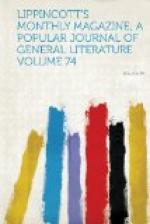At length the wretched work was ended, and the negroes made their way along the moonlighted lanes to their cabins. These were single rooms, built of unhewn logs, chinked and daubed with yellow mud. They had puncheon floors and chimneys built of sticks and clay. Of clay also were the all-important jambs, which served as depositories of perhaps every household article pertaining to the cabin except the bedding and the stools. There might have been found the household knife and spoon, the two or three family tin cups, the skillet, the pothooks, sundry gourd vessels, the wooden tray in which the “cawn” bread was mixed—pipe, tobacco and banjo.
On the Horton place the negroes cooked their own suppers after the day’s work was over. So for an hour every evening “the quarter” had an animated aspect, for the cabins, standing five yards apart, faced each other in two long lines. In each was a glowing fire, on which logs and pine-knots and cypress-splints were laid with unsparing hand, for there was no limit to the fuel. These fires furnished the lights: candles and lamps were unknown at “the quarter.”
Of course the windowless cabins, with these roaring fires, were stifling in September; so the negroes sat in the doorways chatting and singing while the bacon was frying and the corn dough roasting in the ashes or the hoecake baking on the griddle. An occasional woman patched or washed some garment by the firelight, while others brought water in piggins from the spring at the foot of the hill on whose brow “the quarter” was located.
As Alston sat outside his door on a block, eating his supper by the light of the high-mounting flames of his cabin-fire, Little Lizay came out and sat on her doorsill. Her cabin stood opposite his. He recognized her, and when he had finished his supper he went over to her.
“I didn’t want ter strike yer, Lizay,” he said. “Do you feel haud agin me fer it?”
“No,” Lizay answered: “he made yer do it. Yer couldn’t he’p it. I reckon yer’ll have ter whip me agin ter-morrer night. I mos’ knows my baskit won’t weigh no two hunderd an’ fawty-seven poun’s. ’Tain’t fa’r ter ‘spec’ that much from me: it’s a heap more’n tother gals gits, an’ mos’ all uv um is heap bigger’n me. I’s small pertatoes.” She laughed a little at her jest.
“Yer’s some punkins,” said Alston, returning the joke. “I’d give a heap ef I could pick cotton like yer.”
“Yer’s improved a heap,” said Little Lizay. “Ef yer keeps on improvin’, mayby yer’ll git so yer kin he’p me arter ’while.”
“Mayby so,” Alston answered.
“But yer wouldn’t he’p me, I reckon. Reckon yer’d he’p Edny Ann: yer likes her better’n me.”
“No, I don’t.”
“Reckon yer likes somebody in Virginny more’n yer likes anybody on this plantation.”
“I’s better ’quainted back thar’,” said Alston apologetically.
“But thar’ ain’t no use hankerin’ arter them yer’s lef ‘hin’ yer: reckon yer won’t never see um no mo’. Heap better git sati’fied yere. It’s a long way back thar’, ain’t it?”




